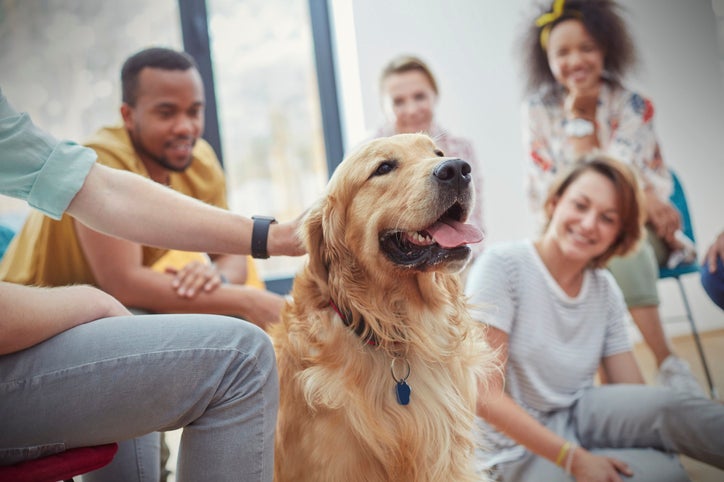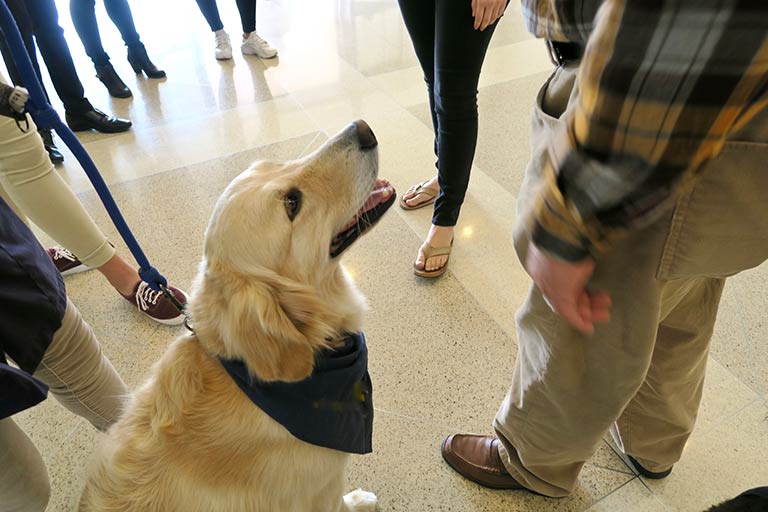
At a Glance:
- Researchers identified four distinct therapy dog handling styles: hands-off, permissive, authoritative, and authoritarian
- The new study suggests the dog’s handler may impact the success therapy dog sessions
Therapy dogs can have a tremendous impact on the people they interact with. From senior centers to hospitals to schools, these dogs bring joy and calm to those looking for some canine love and cuddles. And although the dog is the one getting all the attention, make no mistake, therapy dog work is a team sport.
Not only is the owner responsible for the dog training and coordination of the visitation schedule, but the owner also handles the dog during the visits as well. But not every therapy dog owner handles their dog in the same way. Some are more permissive; others take a hands-off approach. Could handling style affect the dog and therefore the success of animal-assisted activities (AAAs)? New research suggests that the way a handler interacts with their dog may potentially have an important impact on the therapy visit.
Recent Research
Researchers at Washington State University and State University of New York recently examined the relationship between handlers and their dogs during AAAs on university campuses. The effectiveness of AAAs has been a popular topic of study, but the effect of the handler had until now been overlooked. This study looked at how the handlers interacted with their dogs both before and during a session with a university student.
Although they may not seem like the stereotypical recipients of therapy dog sessions, studies have shown that university students benefit greatly from the opportunity to interact with therapy dogs. These students experience high levels of academic stress which is linked with anxiety, depression, and suicidal thoughts not to mention lower grades and higher drop-out rates. To date, almost 1,000 campuses have started animal visitation programs to give students the chance to have hands-on sessions with therapy animals. Even just a few minutes of petting a dog can boost a student’s mood and decrease negative feelings. So, the more successful these visits can be, the better.
In the current handler-dog connection study, the scientists videotaped 29 therapy dogs (over half of which were Golden Retrievers or Labrador Retrievers) and their handlers as they interacted with 212 undergraduate students in small group sessions. The first five minutes of each recording was taken before the students entered the AAA area when the handler and dog were alone. The second five minutes was of the students interacting with the dogs. These recordings were then analyzed for any dog-directed behavior on the part of the handler such as touching or talking to the dog.

Four Different Handler Styles
The results showed that the handlers spent significantly less time petting their dog when the students were present. They also spent significantly more time sitting on the floor and restraining their dog by the leash when the students were around.
In addition, the researchers identified four distinct therapy dog handling styles:
- hands-off
- permissive
- authoritative
- authoritarian
“Hands-off” handlers showed low warmth and low control scores. In other words, they might have sat quietly without interacting with their dog or instead have chatted with other handlers.
“Permissive” handlers scored high for warmth with a low control score. So, they might have frequently patted or praised their dog without restraining their dog or giving behavior cues like sit or down.
“Authoritative” handlers were those with high warmth and high control scores. For example, those handlers who often asked their dog to sit or lie down and then pet and praised the dog when he or she obeyed.
Finally, “authoritarian” handlers scored low on warmth but high on control. In other words, they might have frequently given physical or verbal cues to their dog without praise or petting when their dog obeyed. Finally, the interaction styles of the handlers were affected by the presence of the students, but not all in the same direction. Some handlers showed more warmth to their dogs around the students while others showed less.
Does Handler Style Matter?
It’s interesting, although perhaps not surprising, that there was such a range of handler behavior. Some may have felt protective of their dogs. Others may have not wanted to interfere with the students’ experience. However, the key issue is whether the behavior of the handler makes any difference to the dog and to the student taking part in the AAA. First, consider the dog.
The handler is the dog’s advocate, protecting him or her from stressful situations. And previous research has shown that a dog’s stress level can be influenced by the quality of the dog-handler relationship. As dogs being used in AAAs are working for our benefit, we owe it to them to be sure we are interacting with them in the most stress-free and positive way. Only by identifying handler styles and further studying their effect on therapy dogs can we be sure we’re doing our best for them.
Second, consider the recipient of the therapy dog session. The relationship between the therapy dog and the handler could potentially affect the quality of the AAA. A hint that this might be the case comes from another research study with university students that found that students reported a greater boost in mood after an AAA when only the dog was present versus the dog and the handler. Although that study didn’t look at handling styles, it does suggest that the handler isn’t an invisible part of the experience.
It could be that a hands-off approach works better for successful AAAs because the recipient can interact with the therapy dog uninterrupted. Or perhaps an authoritative style keeps the dog behaving at his or her best putting the recipient at ease. Only further study of the four different handling styles will provide more information about what is best for the dog and what is best for the AAA recipient. Perhaps scientists will discover that the greatest boost of all to therapy dog sessions is the strength of the handler’s bond with their therapy dog.

